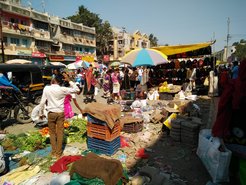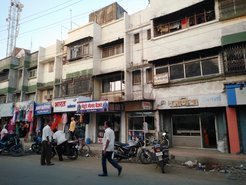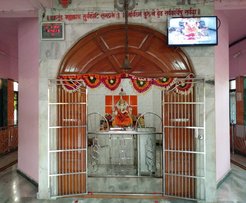Unpacking a Maharashtrian Town and its Family Firms
Author: Sudeshna Chaki
April 22, 2016
The field site selected for India in the REALEURASIA project is a town in the state of Maharashtra. Palghar district has a total population of almost 3 million, distributed in 8 tahsils. Palghar Tahsil has a population of around 550,166. Within the Palghar Tahsil, I am focusing on the conurbation around Palghar Municipal Council, which is also referred to as Palghar town. While this town had a population of only 52,677 at the census of 2001, the urban area has long expanded beyond the boundaries of the municipality to incorporate a few of the surrounding areas. Palghar is primarily categorized as a tribal district as about 37% of the total population is tribal. In Palghar Tahsil the figure is around 30%. In the first section of this blog post I will provide a descriptive account of my field site, by giving an idea of how it looked in the past and in the present. In the second part I will touch upon some of my experiences with regard to anthropological fieldwork. The final section focuses on firms conforming to the common perception of a family business.
During the British Raj, Palghar was a village. In 1893 it got its own railway station as part of the British government’s initiative to facilitate their cotton trade from Baroda to England via Bombay.1 This, coupled with migration of wealthy people driven by epidemics in the surrounding areas, kicked off its transformation. Today, it’s a fledgling city. In the narratives of some informants who arrived thirty five years ago, many parts of the town, where commercial and residential establishments predominate today, were still covered with forests and horse driven carts were conspicuous in the town. From the narratives of the locals, one can construe that Palghar’s urbanization gained further momentum as people from different parts of the country, as well as the state of Maharashtra, came here to seek work in new industries. In the aftermath of the 1980s India witnessed the inception of economic liberalization, where creating a comfortable space for markets and private enterprises became a priority for policy makers. Policies were introduced to encourage small scale industries which relaxed control and granted incentives on capital, taxes and the import of machineries. The ethnic diversity of the workforce is visible today among business owners as well. Other than the manufacturing industries, people from Gujarat, Bihar and Rajasthan are visible running shops and restaurants. Although local Maharashtrians are not absent in the business domain, they are not the dominant group. It is generally agreed both by the locals and outsiders that local Maharashtrians prefer secure jobs, especially public sector jobs, with their comfortable working hours, over the uncertainties of business. Although this diversity is visible in the Palghar town area, Maharashtrians (including tribals) are the dominant group in other parts of Palghar district. On Fridays, there is an open market in the town and Maharashtrians from the surrounding rural areas come into town to sell farm produce and fish.


The ethnic diversity is reflected in the religious landscape of the town where many temples co-exist. Besides the Ganpati temple, Lakshmi-Narayan temple and Ram temple which are temples of deities popular among Maharashtrians, an Amba Mata temple has been established by the Gujarati community and an Ayappa Vishnu temple by the South-Indian community. These temples once (sometimes twice) a year organize events like bhandara (where the temple committee feeds people). Since Hinduism also involves worship at home, almost every household (and business) that I visited has a sacred shrine with images and/or idols of Hindu deities which are worshipped daily. Religious occasions such as Haldi KumKum or Makarshankranti strengthen community ties and establish social networks as women visit houses in the neighborhoods and exchange sweets and small gifts.
In addition to mainstream Hinduism, many urban residents participate in socio-religious sects and movements. One example is Swadhyay Parivar, initiated by Pandurang Shastri Athavale to promote a particular interpretation of Hindu scriptures such as the Bagavad Gita, the Vedas and the Upanishads. Its members arrange weekly meetings. Additionally Vastu shashtra (a traditional Hindu system of architecture) and astrology also feature in people's belief systems. For example, I came across business histories where the name of the company is fixed by consulting a numerologist, or Vastu experts were consulted before building factories, offices or houses. In a syncretic belief system, all the above interact in a non-trivial manner. I am in the process of uncovering the subtle ways in which these beliefs and practices influence people's morality and economic action. Of course, interviews and casual discussion do not suffice for grasping these matters. Only a long term relationship of trust, coupled with the luck of being present in the right place at the right time, enables the ethnographer to inch closer to such understanding.
Conducting fieldwork in Palghar
Conducting fieldwork in a setting where your research topic is hardly understood, and may even be viewed with scepticism, is a challenge. I have been actively tackling this challenge through a combination of surveys, informal interviews and participant observation. The kind of insight this research aims to collect, however, needs a deeper level of engagement. Visiting different businesses on a sporadic basis is not enough. A lack of familiarity with research methods other than paper-based surveys, often makes things difficult for the researcher. At the outset, the absence of statistical data on businesses, including family businesses, made it quite hard to locate a starting point. To locate family business I was obliged to rely on informal sources and to check its reliability personally. I came to know about two local business associations and through one of them I was able to make a list of businesses where more than one family member was involved. Getting appointments with business owners was a time consuming process. Some were sceptical, some were scared and some were uninterested. Randomly approaching businesses seldom worked; it was mandatory to have a respected middleman who could introduce you to the businesses. Luckily after a while I met a businessman whose name helped me to get access to a few other businesses in the area. Most of small scale manufacturing and processing entrepreneurs who I have interviewed so far commute daily by train from different localities in Bombay. Some purchased land here during the 1980s when capital investment was subsidised and temporary exemptions from purchase tax and sales tax were granted. The units of these businesses in Palghar are limited to manufacturing, while the sales offices are located in Bombay.
In Palghar, the term family business is commonly associated with businesses that have been passed down through generations. Such businesses share a common pattern in their history and self-representation. The current owners describe how their father started from a small sized firm and expanded it over the years through his hard work. Their perseverance, ability to take risks, proper judgment and frugality are among the reasons put forward for the success of the founders. They did not have the necessary experience to run a business in the beginning but they learnt it while running these enterprises hands-on. This accumulative knowledge derived from experience was then transmitted to their children by involving them in the business at a rather early age. Incidents featuring in these narratives often portray a strong image of family bonding and mutuality. The second (current) generation, however, did not engage their children at a younger age. Instead, the children of current business owners were encouraged to obtain formal qualifications by taking specific courses in higher education related to their business sector. With the help of these professional skills acquired by the new generation, the present owners plan to expand the business. The sons know from an early age that this is expected of them by the family, and most do not even consider alternative career options. These businesses take pride in presenting their story of successful development through generations, contrasting themselves to cases where internal family dispute have caused businesses to fall apart. Through these stories, they paint a picture of a family that is enriched with familial values, that knows how to care for more than just the individual self, where children obey the parents’ decisions and elders take decisions as a family. In one such business, run by two brothers and their sons, one of the brothers emphasized to me how the decision to split the company had been entirely mutual and implemented without acrimony or hard feelings. He invited me for lunch at his factory kitchen, where his brother and nephew still came for lunch every day, even though their enterprise was now legally separate. Though the narratives highlight exploits in the domain of business, they often also project their success as a joint family, a household form that is declining in the new neoliberal era, as the pace of life accelerates and priorities are rethought.
Other than the above-mentioned manufacturing units that have been passed down for at least one generation, I have also been engaging with more recently established enterprises. I have been studying retail businesses like groceries, tailors, various entrepreneurs in the medical and garments sectors, in construction, an offset printing press, an astrologer, food vendors, a grass trader, bakers, and others. In the remaining months in the field I aim to sharpen my focus and develop a deeper level of engagement with a few of these businesses. My plan is to maintain my current approach of participant observation, supplemented by informal interviewing whenever the situation allows, in addition to using our more formal survey instrument.
The combination of observations and narrative interviewing has already given me lots of insights into how religion comes into play in businesses and in economic activities in general. This entanglement involves both a visible and non-visible dynamic. In the visible dynamic, it is common to name shops and businesses after deities and to adorn the workplace with photographs of religious gurus and gods. Conspicuous rituals to worship Ganapati and Lakshmi are performed for the firm's prosperity, and bright yellow marigold garlands are placed on factory machinery on certain auspicious days, accompanying prayers for prosperous operations. The non-visible aspect becomes apparent once I go deeper into my respondents’ reasoning for these performances and the decisions they have taken, when notions such as Karma come to the forefront. I have come across businessmen who do not speak of themselves as religious or spiritual, but who nonetheless evoke the idea of karma in their narratives and justifications. Probing deeper into these attitudes is a challenging task, but it seems that I am looking at the right places.

1 http://dtp.maharashtra.gov.in/site/forms/admin/ddtp/konkan/thane/REPORT/Palghar/2.pdf


